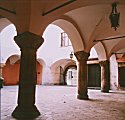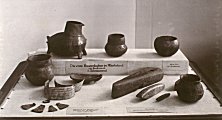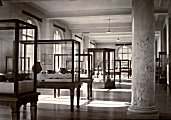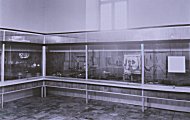Lech Krzyżaniak, Danuta Prinke
From the
showcase mentality to the multimedia one: the new permanent display in the
Archaeological Museum in Poznan.
Paper presented at the 6th Annual Meeting European Association of
Archaeologists, Lisbon, 10-17th September,
2000.
Acknowledgements
We would like to thank the organisers of this
session for the invitation sent to the Poznan Archaeological Museum. The reason
for this was the controversy surrounding the opening three years ago of the new
permanent exhibition entitled “The Prehistory of Greater Poland”
. Unfortunately one of the authors of this paper - Professor Lech Krzyżaniak, who is also the director of
our Museum and general coordinator of the exhibition was unable to arrive here. I hope it will be possible for me to
replace him here. I am the custodian of this exhibition and author of the
concept of the part which concerns the Stone Age.
Before we share with you our experiences of the
different stages of the preparation of the exhibition, and the first three
years of its functioning, we would
like to say a few words as an introduction. Let us shortly present our region, our town and the Museum.
This is a
map of Poland with the boundaries of our region of Greater Poland (Wielkopolska).
It is from this area that the majority of the material in our collections has
come, and it is in this area that the present activities of our museum are
concentrated . It is the prehistory of this area which our exhibition covers.
The capital of Greater Poland is the town of Poznañ.
The Górka
palace, built in Renaissance style, was in the XVI century the residence of the
Górka family, an important magnates family in the area. It is situated in the
very centre of the town, on the main
tourist routes. Since 1966 this palace has been the seat of the Poznañ
Archaeological Museum.
The main
entrance to the Museum.
View
of the Museum from the courtyard.
At the beginning I should explain
that we have broadened the scope of the presentation, describing both the past
and present conditions of functioning of the Poznan Archaeological Museum. As
such, we may fully enter into discussions on the condition of European museums;
we may also better show the models of our former exhibitions.
Our Museum has a 140-year tradition
and one could say without too much pathos that its history reflects the
political history of our region and country. The Museum came into being when
there was no country called ‘Poland’ on the map of Europe, and the area was
ruled by foreign powers. The creation of a Polish cultural institution,
competing with the official ones of the Prussians, had the aim of preserving of
Polish national identity and was an expression of patriotism. Until the
recovery of political independence in 1918, both Polish and German cultural
institutions functioned side by side, creating collections and organising
archaeological exhibitions. On this rather politicised basis arose a number of
disputes about the ethnic attributions of these territories which in
archaeology was transformed into a dispute about whether the peoples living
here in Antiquity were Slavs or Germans.
Slide 5, 6, 7,8
From the
conceptual point of view, all former exhibitions were very similar; one may
call them “collectioner’s “ displays:
rows of showcases filled with valuable artefacts ordered after
chronological and cultural classification, each object accompanied by a
detailed label.
After 1945,
when science and cultur became dominated by the pression of Communist ideology,
in differing degrees in individual disciplines, archaeology was one of them. It
proved useful in illustrating the thesis of the integrity of Polish territory,
in the promotion of anti-German attitudes and also in demonstrating the
nearness of Poland and Russia in the past.
Museums thus, functioning at the interface between science and society,
served to popularise the one “correct” manner of thinking.
For a long
time the pattern was dictated by “political correctness”, but in those days the
term had a somewhat different meaning.
It may be surprising, but in this period our activities were
characterised by a subconscious “self-censorship”, the filtering of information
presented in displays for their “political correctness”. Permanent exhibitions,
by virtue of their long life were unsuitable for the ongoing needs of politics,
but they arose in the above-mentioned atmosphere. It is worth noting that it is
only in the last few years that the fact of the long-term existence on Polish
territory of Germanic tribes in the first centuries AD has not raised any
political emotions.
In the
years 1945 - 1962 five permanent exhibitions were prepared. They were all based
on the same “showcase philosophy” from the pre-War period.
Financial
problems limited the possibilities of introducing major changes. Despite this a
new display was created for the new museum in the Gorków Palace, which was opened in 1965.
Slide 9, 10,11
This exhibition was to last until
1995 because of the economic crisis of the state and the continuous lack of
finances for the new display, especially in the final years of the existence of
the Polish People’s Republic. It is understandable that, after thirty years,
the display no longer attracted public attention and was generally criticised.
At the time when it was created, it was novel in its technical resolution and
manner of presentation of prehistory. It was very scientific and due to this
very hermetic, showing in a detailed manner an analytical picture, using
statistics and specialist terms. Apart from this it was too monotonous and
long. A visit to the museum involved negotiating a labyrinth of cases crowded
into several rooms. It was in opposition to such a model that we created a new
conception.
It should
also be said that only the new political realities (since 1989) and the
decentralisation of the management of culture have meant the connection of the
activities of regional cultural institutions with local communities and the
authorities which it elects (in the case of our museum this means the Town
Council of Poznan). This enables serious considerations of the possibility of
obtaining suitable financing for the preparation of a new permanent exhibition.
Earlier attempts at changing the exhibition which opened in 1965 (and thus on
display for over 30 years) were met with the statement that funds were
unavailable. On another hand, being an institution supported by the state
budget for culture we could not individually seek outside sponsorship.
The
changed political situation, the support of the new local authorities and the
desire to improve the neglect of many years were not enough. Most of the
region’s cultural institutions were in a similar situation and they all needed
considerable financial investment. It was necessary to learn how to compete for
a good budget by careful design of proposed changes, building the prestige of
the institution, in order to justify to the local community the existence of
the Archaeological Museum.
This was a
process which lasted many years, but bore fruit. Due to finances received from
the Town Council it was possible in a period of the past six years to carry out
a series of changes improving the picture of our museum, including the
preparation of two big permanent exhibitions (the one on prehistory of the
region and another one concerning Ancient Egypt) as well as, advanced
computerisation of the Museum (supported by outside funding, including grants
from the Polish Committee of Scientific
Investigations and the European Union - in the framework of the ArchTerra
project also presented at this conference), and a thorough renovation of the
museum building itself. From today’s perspective one can say that the present good
situation of the museum is due to several favourable circumstances:
1/ an improvement in the town’s economic situation and its administrative independence,
2/ the popularity of archaeology in the media and a generally favourable situation for archaeology as a result of giant rescue works carried out in advance of the construction
of the transcontinental gas pipeline and Polish motorway system,
3/ the success of a temporary exhibition on Ancient Egypt organised in 1995 with material from the Egyptological Museum in Berlin.
Such a
degree of interest, measured in hundreds of school children daily and queues of
individual visitors mainly on Saturdays and Sundays, has not been shown in the
case of any other archaeological exhibition in Poznań;.
On the basis of this wave of public interest in
archaeology it was possible to convince the municipal authorities to finance
two more permanent exhibitions at an interval of two years and also to find a
few sponsors willing to support local initiatives.
In the
light of what has been said above, one
can clearly see that it is only in the last ten years, in a democratic country,
that the museum has been able to function in a completely normal manner and
gradually make good previous neglect.
****
I would
like now to describe the concepts behind the permanent exhibit, “The
prehistory of Greater Poland”. I shall start with the statement that
there is no theory of archaeological exhibitions and no such subject appears in academic courses taught in Poland.
The form of newly-created exhibits is thus decided by a number of factors. I
have already stated that the concept of the new display arose in opposition to
that of 1965, and its creators were the younger generation of museum staff and
artists contracted in from the outside.
It was them who played a key role in the creation of the friendly
atmosphere of the exhibit. The production of the display took three years of
close cooperation of a group of about twenty people with the willing help of
the whole of the Poznañ archaeological milieu. We were well aware that -
due to the considerable finacial outlay
it involved - the new exhibit
will also be on display for a long time. We were aware also that it
would not be possible to create a display that would satisfy everybody, which
is why we defined its main audience and it is to them that its general
meritorial and technical parameters are addressed. I will describe them now,
illustrating what I say with examples from the display.
The
exhibit is to serve as a supplement to history lessons, giving a basic overview
of the earliest history of the region suited to the perception of primary and
secondary schoolchildren, in the time of a typical lesson. The idea of a
regional exhibit met with favour from both local authorities, which in the new
political reality of our country willingly support the idea of regionalism, as
well as schools which make use of what we have to offer and here conduct their
first history lessons. In directing the exhibit to children in the era of the television and Internet,
we based our ideas on entirely new meritorial and exhibition concepts,
approaching the idea of multimedia information.
This is a
plan of our display. The prehistory of the region is approached from the angle
of seven contrasting sequences of problems, reflecting in a synthetic, and at
the same time dynamic, manner the changes occurring in the development of local
communities in the first 12 000 years of their history . Instead of a line of
showcases stuck against walls a monolithic display block has been created, of
area of 70 square metres, which has been placed in the centre of
specially rebuilt galleries. This allows the exhibit to be seen from all sides
by a large group of people in constant movement, but also permits the use of
the walls for textual information.
As a
result of this, textual informations are outside the main flow of the exhibit,
and thus do not detract from the picture it presents, but give the visitor more
general information on a certain era, described in its European background. In
the construction of a narrative the pictorial form predominates.Presenting the past involves creating the illusion of the
prehistoric reality by:
- creating
spatial depth , allowing multiplanar presentation,
- using a
painted background, emphasising important characteristics of the natural
environment or
·
mood of the place and by:
Slide 18, 19, 20
- introducing actors and their props, there
are over 100 models of people, animals,
houses and different items: the models, designed on the basis of the current
archaeological knowledge, were made of different forms of epoxy resins in three
different scales 1:1, 1:10 , 1:100); and by
·
showing archaeological artefacts or their copies in
contexts which allow their function to be ‘read’ without the need for detailed
labels under each object, for instance:
·
a stone-worker makes a hole in stone axes and next to
him -
·
the ready-made products and waste or
·a Roman period warrior in full armour, and next to
him the archaeological remains of a
shield, umbo and grip).
It was
assumed that such a display would awaken the imagination of the viewer, provoke
him into thinking, connecting facts, and deciphering the knowledge encoded in
individual pictures. Some however accuse our display of postmodernism and a
lack of so-called order, call it unsystematic and lacking detailed labels.
Today, after three years of the functioning of the exhibit, we know that it is
very well received by young people, teachers and large numbers of
archaeologists and archaeology students. The film-like character of the display
is emphasised, allowing one to think up one’s own stories, facilitating the
comparison of different periods, and
the asking of questions and awakening an interest in the past.
Finally, I would like to add that
the exhibit is also suitable for multimedia presentation. It will soon be fully
present on the Internet. At the moment
a short form of the presentation is included into our museum’s website.






















